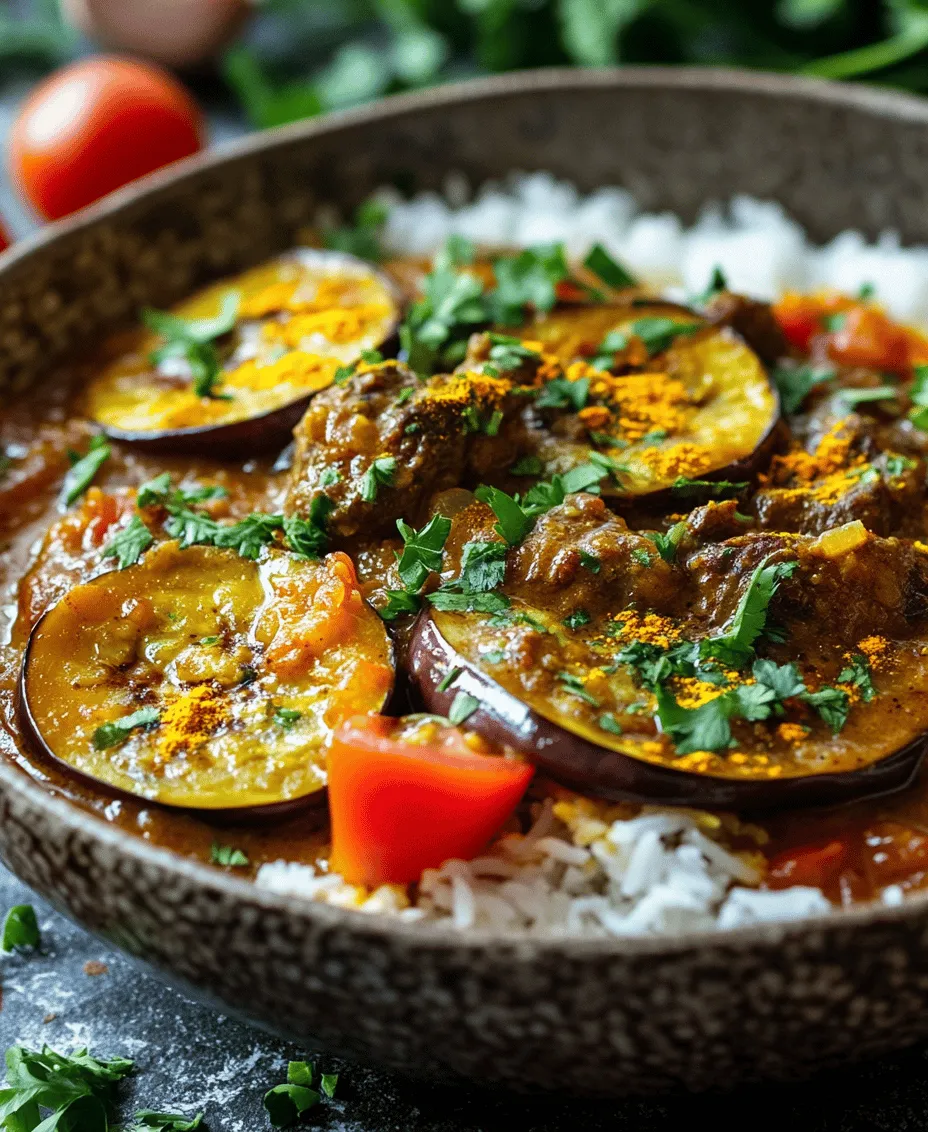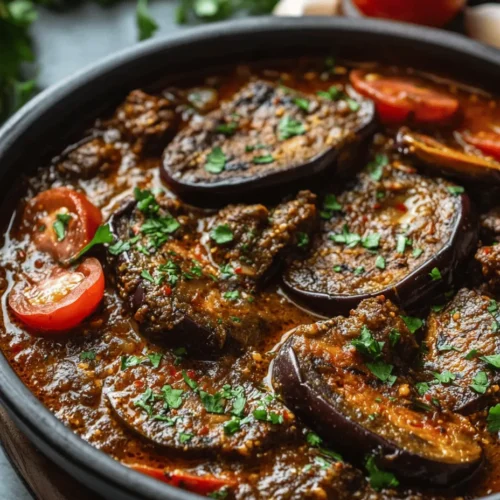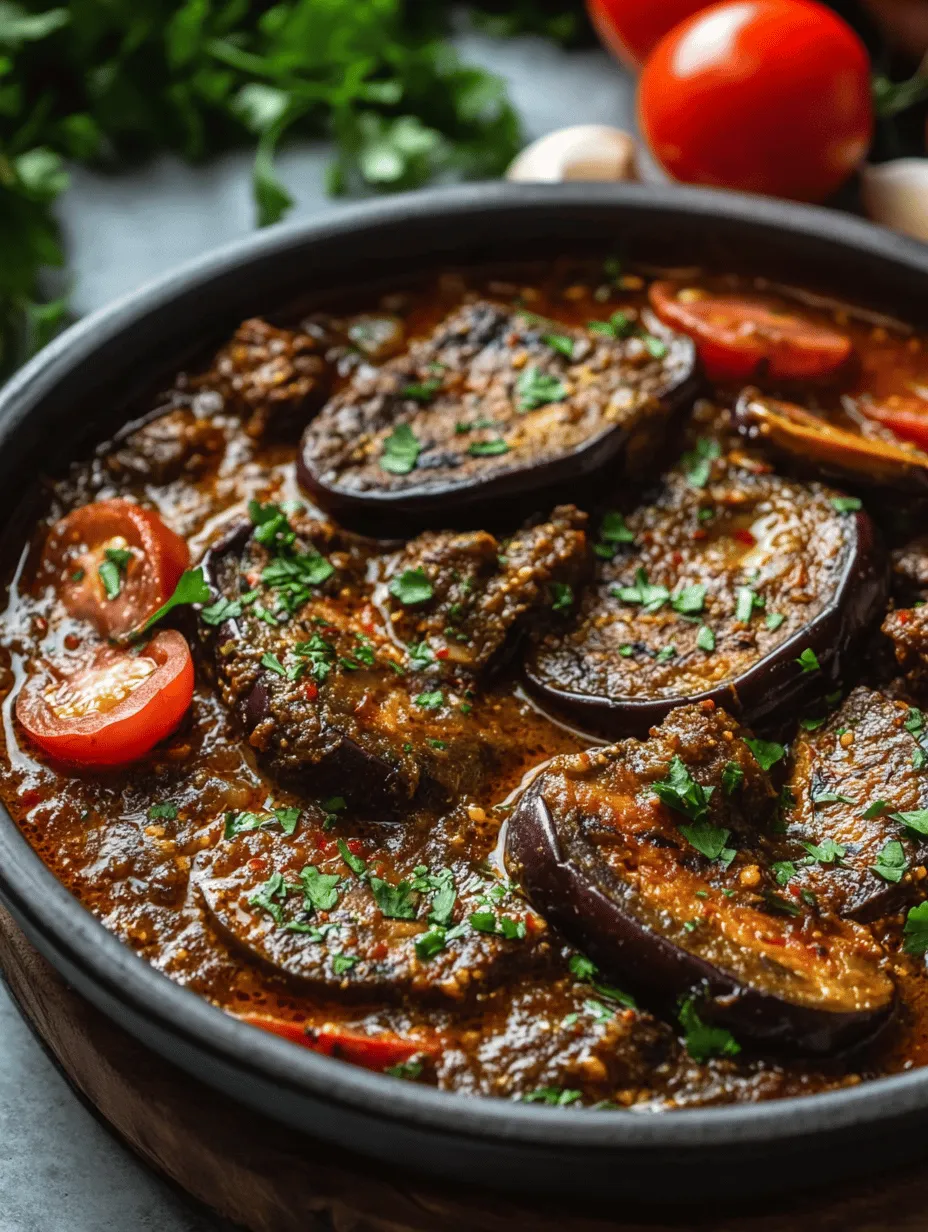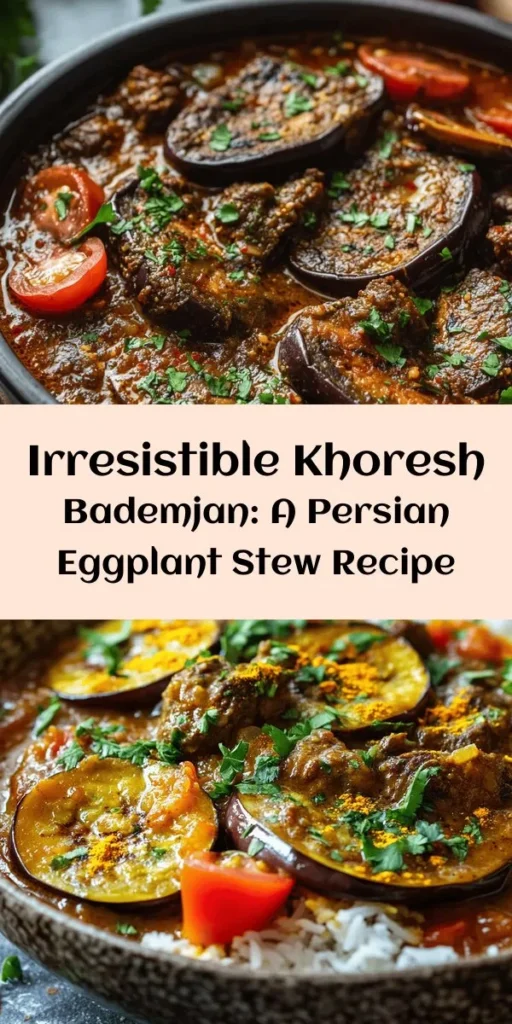Persian cuisine is renowned for its rich flavors, intricate spices, and vibrant dishes that tell a story of tradition and culture. At the heart of this culinary heritage lies a category of dishes that holds a special place in Iranian households: stews, or “khoresh.” Among these, Khoresh Bademjan stands out as a beloved classic, celebrated for its delicious combination of tender meat and succulent eggplant, all enveloped in a fragrant, spiced sauce. This dish not only serves as a staple in Persian kitchens but also plays a significant role in family gatherings and festive occasions, embodying the warmth of hospitality and the joy of sharing.
Khoresh Bademjan, which translates to “eggplant stew,” is a dish that showcases the beauty of Persian cooking. The unique flavors and textures come from a harmonious blend of ingredients, each contributing to the stew’s overall profile. The tender meat, traditionally beef or lamb, pairs beautifully with the creamy eggplants, while aromatic spices and sautéed onions create a base that is both comforting and complex. It’s a dish that invites you to explore the depths of Persian culinary tradition, making it a must-try for anyone interested in the rich tapestry of global cuisine.
Understanding the Key Ingredients of Khoresh Bademjan
To truly appreciate Khoresh Bademjan, it’s essential to understand the key ingredients that come together to create this delightful stew. Each component plays a vital role in shaping the dish’s flavor, texture, and overall experience.
Eggplants: The Star Ingredient
Eggplants are undoubtedly the star of Khoresh Bademjan, providing both texture and flavor. The variety of eggplant used can greatly influence the dish. While many types can be utilized, the most common choice is the globe eggplant, known for its meaty texture and ability to absorb flavors. When preparing eggplants for this recipe, salting is a crucial step that shouldn’t be overlooked.
Salting helps to draw out the bitter moisture from the eggplants, resulting in a firmer texture and enhancing their ability to soak up the rich stew flavors during cooking. To salt the eggplants, slice them into rounds or cubes, sprinkle generously with salt, and let them sit for about 30 minutes. Afterward, rinse and pat them dry, ensuring that they are ready to be fried to perfection.
Meat Choices: Beef or Lamb
When it comes to the meat in Khoresh Bademjan, both beef and lamb make excellent choices, each bringing its own distinctive flavor profile to the dish. Beef is often favored for its robust taste and tenderness, while lamb adds a unique richness that complements the earthiness of the eggplants.
Regardless of your choice, the method of cooking remains consistent: the meat should be browned first to develop a deep, savory flavor through the Maillard reaction. This technique not only enhances the taste but also contributes to the stew’s overall complexity.
Aromatic Vegetables: Onions and Garlic
Onions and garlic form the aromatic backbone of Khoresh Bademjan, infusing the dish with a depth of flavor that is both rich and inviting. Onions should be finely chopped and sautéed until they turn golden brown, releasing their natural sweetness. Garlic, minced or sliced, should be added towards the end of the onion cooking process to avoid burning while still imparting its aromatic essence.
The careful timing of these ingredients is essential; undercooking them can lead to a lack of flavor, while overcooking can result in bitterness. The goal is to achieve a caramelized base that serves as the foundation for the stew.
Spices: Turmeric, Cinnamon, and More
The spices used in Khoresh Bademjan are what truly elevate the dish, adding layers of flavor and warmth. Turmeric is a staple, providing a vibrant yellow color and earthy flavor, while cinnamon introduces a subtle sweetness that balances the richness of the meat and eggplant.
Other spices, such as black pepper and sometimes saffron, can also be included to enhance the dish’s complexity. Beyond their flavor contributions, many of these spices boast health benefits, making Khoresh Bademjan not just a delicious meal, but a nourishing one as well.
Tomatoes and Tomato Paste
Tomatoes play a crucial role in Khoresh Bademjan, bringing acidity that cuts through the richness of the stew. Fresh tomatoes can be used, but for a more concentrated flavor, tomato paste is often added. When selecting tomatoes, look for ripe, juicy varieties that will provide the best flavor.
Incorporating tomatoes into the dish helps to create a balanced sauce that envelops the meat and eggplants, allowing the flavors to meld beautifully during the cooking process.
Step-by-Step Guide to Preparing Khoresh Bademjan
Preparing Khoresh Bademjan may seem daunting at first, but with a clear step-by-step guide, you’ll find it to be a rewarding culinary adventure. Below are the essential steps to creating this flavorful Persian eggplant stew.
Preparing the Eggplants
The first step in preparing Khoresh Bademjan is to get the eggplants ready. Begin by choosing firm, shiny eggplants without blemishes. Slice them into rounds or cubes, depending on your preference. Once cut, generously sprinkle them with salt and allow them to sit for about 30 minutes. This process draws out excess moisture and bitterness, creating eggplants that are tender and flavorful.
After 30 minutes, rinse the salted eggplants under cold water to remove the salt and any bitterness, then pat them dry with paper towels. This step is crucial for achieving the right texture during frying, as excess moisture can lead to sogginess.
Frying the Eggplants
Next, it’s time to fry the eggplants. Heat a generous amount of oil in a large skillet over medium heat. The oil should be hot enough that the eggplants sizzle upon contact. Fry the eggplant pieces in batches to avoid overcrowding the pan, which can lead to steaming rather than frying.
Aim for a golden-brown color on each side, which usually takes about 3-4 minutes per side. This step not only enhances the flavor of the eggplants but also helps to develop a rich, caramelized taste that will elevate the overall dish. Once fried, transfer the eggplants to a paper towel-lined plate to absorb excess oil.
Sautéing the Aromatics
With the eggplants ready, the next phase is to sauté the aromatics. In the same skillet used for frying the eggplants, add more oil if necessary and heat it over medium heat. Add the chopped onions and sauté until they become translucent and start to turn golden, which usually takes about 5-7 minutes.
Once the onions are ready, add the minced garlic and sauté for an additional minute until fragrant. This technique is vital for creating a flavorful base for the stew, as properly sautéed onions and garlic will impart a rich depth to the dish.
Browning the Meat
After the aromatics are cooked, it’s time to add the meat. Increase the heat to medium-high and add the beef or lamb to the skillet. Allow the meat to sear without stirring for several minutes to develop a nice brown crust. Once browned on all sides, season with salt and pepper, and stir to combine.
Browning the meat is essential for building flavor, as it adds a savory richness that complements the eggplants and spices beautifully. After the meat is well-browned, you can proceed to combine the other ingredients.
Combining Ingredients for Maximum Flavor
Now that all components are prepared, it’s time to bring everything together. Begin by adding the fried eggplants to the skillet with the meat and aromatics. Next, sprinkle in the turmeric, cinnamon, and any additional spices you wish to include. Stir well to coat the meat and eggplants with the spices, allowing them to toast slightly for enhanced flavor.
Then, add the chopped tomatoes and tomato paste, stirring to combine. The acidity of the tomatoes will balance the richness of the meat and eggplants, creating a harmonious flavor profile. Pour in enough water or broth to cover the ingredients, ensuring everything is submerged for even cooking.
Bring the mixture to a gentle simmer, then reduce the heat to low, cover the pot, and let it cook for about one to two hours. This slow-cooking process allows the flavors to meld together and the meat to become tender, resulting in a stew that is both hearty and satisfying.
As the Khoresh Bademjan cooks, your kitchen will fill with tantalizing aromas that beckon you to the table, promising a delicious meal that reflects the rich tradition of Persian cuisine. Stay tuned for the next part, where we will dive into serving suggestions and tips for perfecting this iconic dish.

Simmering to Perfection
Once you have sautéed your ingredients and added your spices, it is time to let the Khoresh Bademjan simmer to perfection. This simmering process is crucial for developing the rich, layered flavors that define this traditional Persian stew. To achieve the best results, cover the pot with a lid, reduce the heat to low, and allow it to simmer gently.
Typically, Khoresh Bademjan should simmer for about 1.5 to 2 hours. During this time, the flavors will meld beautifully, and the meat will become tender. It is essential to check periodically to ensure that the stew does not dry out. If it looks too thick or starts to stick to the bottom of the pot, add a splash of water or broth to maintain a good consistency. The goal is to achieve a stew that is thick enough to coat the back of a spoon but not so thick that it becomes dry.
As you approach the end of the cooking time, check the meat for tenderness. It should be fork-tender, falling apart easily, while still holding its shape. The eggplants will also have absorbed the flavors of the stew, becoming soft yet intact. If you find that the meat is still tough, continue to simmer for another 15-30 minutes before checking again.
Incorporating the Fried Eggplants
Now that your stew is simmering beautifully, it’s time to integrate the fried eggplants. This step requires a gentle touch to ensure that the eggplants maintain their structure while infusing the stew with their rich flavor. Carefully place the fried eggplant slices on top of the simmering stew, ensuring they are evenly distributed.
Using a spatula or a large spoon, gently fold the eggplants into the stew. Be cautious not to break them apart; instead, aim for a motion that lifts the eggplants from the bottom and incorporates them with the sauce. This technique allows the eggplants to absorb the delicious flavors of the stew without losing their integrity.
Once the eggplants are well incorporated, allow the stew to simmer for an additional 15 to 20 minutes. This will give the eggplants a chance to meld with the other ingredients while retaining their unique texture. The result will be a rich, flavorful stew where each bite offers a delightful combination of tender meat and creamy eggplant.
Finishing Touches for Presentation
As the simmering process reaches its conclusion, it’s time to add the finishing touches that will elevate Khoresh Bademjan both visually and in flavor. One of the most beloved enhancements in Persian cuisine is saffron. To incorporate saffron, steep a pinch of threads in a tablespoon of hot water or broth for about 10 minutes. Once infused, drizzle this saffron liquid over the stew. The golden hue and aromatic qualities of saffron will enhance the dish’s visual appeal and flavor profile.
To complete the presentation, garnish the stew with freshly chopped herbs such as parsley or cilantro just before serving. These vibrant green herbs add a fresh contrast to the rich, warm colors of the stew and provide a burst of flavor. You can also add slices of fresh lime or lemon for a splash of acidity that complements the richness of the dish.
Serving Suggestions for Khoresh Bademjan
Khoresh Bademjan is best enjoyed with traditional accompaniments that enhance the overall dining experience. The most popular side for this stew is Persian rice, known as Chelow. This fluffy, aromatic rice serves as the perfect canvas for the rich flavors of Khoresh Bademjan.
Pairing with Steamed Rice (Chelow)
To prepare Chelow, begin by rinsing 2 cups of basmati rice under cold water until the water runs clear. This step removes excess starch and helps achieve fluffy grains. Soak the rice in water for at least 30 minutes, then drain.
In a large pot, bring 4 cups of water to a boil and add a tablespoon of salt. Once boiling, add the soaked rice. Allow it to cook for about 5-7 minutes until the rice is partially cooked and slightly softened. Drain the rice in a colander and rinse briefly with cold water.
Next, return the pot to the heat, adding a couple of tablespoons of oil or butter. Layer the partially cooked rice back into the pot, creating a mound. Use the handle of a wooden spoon to poke a few holes in the mound, which will help steam the rice evenly. Cover the pot with a towel before placing the lid on tightly to trap the steam. Cook on low heat for 30-40 minutes. The result should be fluffy, aromatic rice that pairs perfectly with the Khoresh Bademjan.
Flatbreads: A Complementary Choice
In addition to rice, flatbreads serve as a delightful side to Khoresh Bademjan. Persian lavash or taftoon bread are popular choices, providing a chewy texture that complements the stew. These breads can be used to scoop up the stew, adding an interactive element to the meal.
You might also consider serving it with pita bread or naan, which can be warmed in the oven for a few minutes before serving. The combination of warm, fresh bread with the rich, savory stew creates a satisfying and comforting meal.
Garnishes and Additional Enhancements
To further personalize your Khoresh Bademjan, consider adding various garnishes and optional ingredients. Fresh herbs like mint or dill not only enhance the presentation but also introduce a fresh flavor dimension. For an extra burst of acidity, you can include slices of soaked dried limes, known as limoo amani, which are commonly used in Persian cooking. Their tangy flavor will deepen the stew’s taste profile.
For those who enjoy a hint of heat, a sprinkle of crushed red pepper flakes or fresh chili slices can be added for a spicy kick. These enhancements allow you to tailor the dish to your preferences, ensuring that every bite is a reflection of your taste.
Cultural Significance of Khoresh Bademjan
Khoresh Bademjan holds a special place in Persian culture, often regarded as a symbol of love and hospitality. Traditionally served at family gatherings and celebratory occasions, it embodies the warmth of Iranian hospitality. The dish is often prepared during significant holidays and gatherings, bringing families together to share not only a meal but also cherished moments.
Historically, Khoresh Bademjan has evolved over time, reflecting the agricultural bounty of Iran. Eggplants, which thrive in the warm climate, are a staple in many Persian dishes. As the years have gone by, the dish has maintained its relevance, often being featured in modern Persian cuisine alongside other traditional stews.
Sharing Khoresh Bademjan with friends and family represents a way of connecting with one another over food, fostering relationships, and creating lasting memories. In a world that continues to change, the timeless appeal of this dish remains steadfast, reminding us of the importance of family, hospitality, and the joy of sharing a meal.
Nutritional Benefits of Khoresh Bademjan
Beyond its delightful flavors and cultural significance, Khoresh Bademjan offers several nutritional benefits that make it a wholesome choice for any meal.
Eggplants: Health Benefits
Eggplants, the star of this dish, are low in calories yet high in essential nutrients. They are an excellent source of dietary fiber, which aids in digestion and promotes gut health. Additionally, eggplants are rich in antioxidants, particularly nasunin, which is found in the skin and has been shown to support brain health. Their unique compounds help to reduce inflammation and may even lower cholesterol levels, making them a heart-healthy choice.
Meat: Protein and Nutrients
The inclusion of lean meats, such as lamb or beef, adds substantial protein to Khoresh Bademjan. Protein is essential for muscle repair and growth, making it an important component of a balanced diet. Moreover, the meat provides essential nutrients, including iron, zinc, and B vitamins, which are vital for energy metabolism and overall health.
Spices and Their Health Perks
The spices used in Khoresh Bademjan, including turmeric and cinnamon, are not only flavor enhancers but also offer numerous health benefits. Turmeric, known for its anti-inflammatory properties, contains curcumin, which may help reduce the risk of chronic diseases. Cinnamon, on the other hand, has been linked to improved blood sugar control and heart health. Together, these spices contribute to a dish that is as nutritious as it is flavorful.
Conclusion: The Timeless Appeal of Khoresh Bademjan
Khoresh Bademjan stands as a beloved dish in Persian cuisine, offering a perfect blend of rich flavors, cultural significance, and nutritional benefits. Its combination of tender meat, creamy eggplants, and aromatic spices creates an unforgettable dining experience that transcends generations. Sharing this stew with family and friends not only celebrates tradition but also fosters connections through the joy of cooking and eating together.
As you embark on your journey to prepare Khoresh Bademjan, embrace the experience of cooking and savoring this traditional Persian dish. Whether served at a festive gathering or a simple weeknight dinner, its timeless appeal will undoubtedly leave a lasting impression. So gather your loved ones, fill your plates, and enjoy the delicious flavors of Khoresh Bademjan, a true testament to the rich heritage of Persian cuisine.



